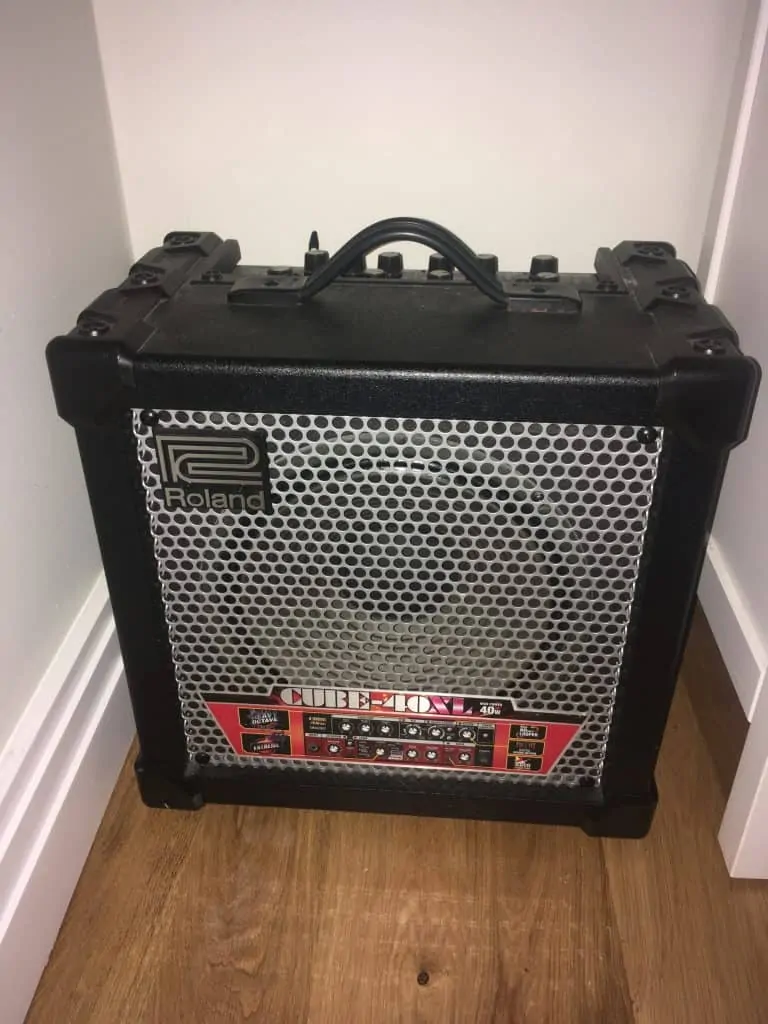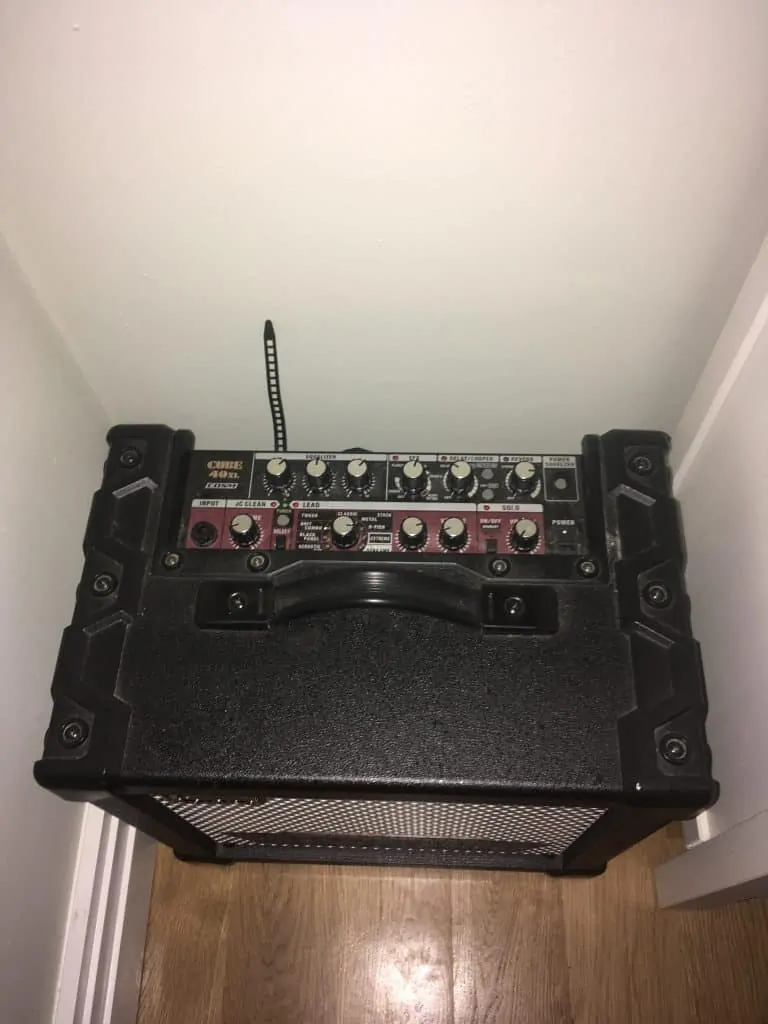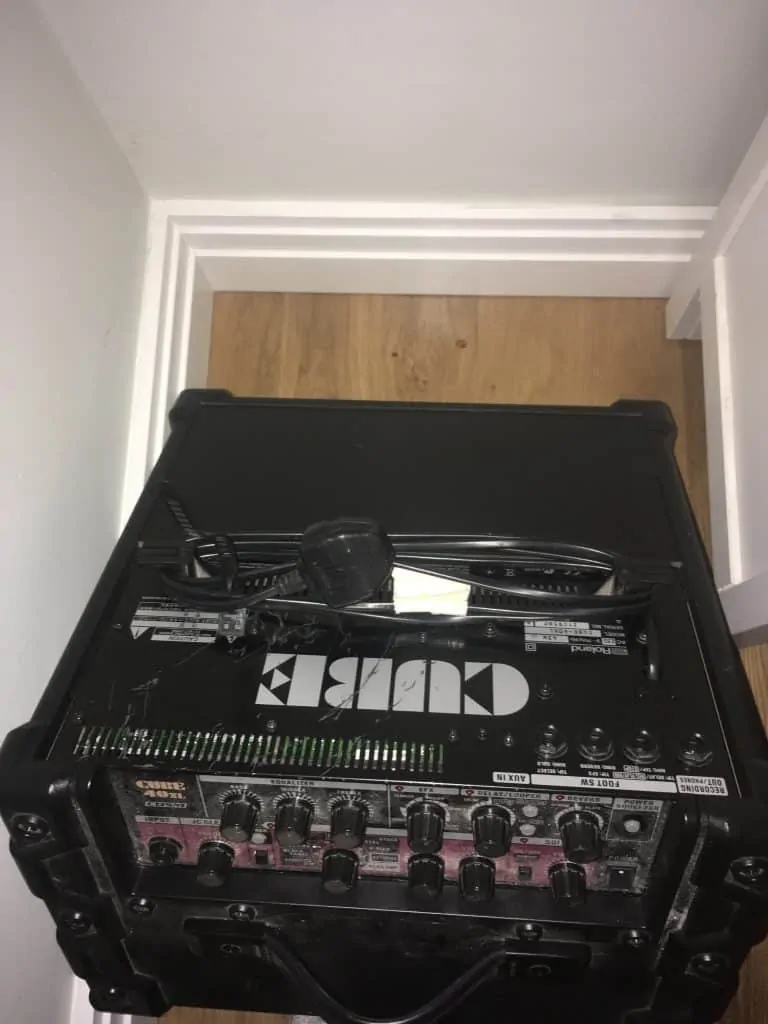At BeginnerGuitarHQ, we aim to help you learn to become a great guitarist. When learning this valuable skill, you need the equipment to go with it, so we put together helpful reviews that’ll give you a head start in deciding what’s right for you!
In this important guide, I’ll talk you through the best Roland Cube amps.
If you’re looking to decide which Roland amp is right for you, then look no further…
Solid-State and Tube/Valve Amps
A solid-state amp essentially uses electronic signals to amplify signal rather than vacuum tubes. A valve/tube amp uses vacuum tubes to amplify the sounds.
This means a solid-state amp is cheaper to produce (and therefore sell), and are typically chosen as practice amps. Also, an effect heavy, ‘modern’ amp will always be solid-state, as they are capable of having digital screens fitted and a vast array of technology added to the output signal. They are also lighter and easier to use than a valve amp. However, the sound quality of a solid-state amp often lacks at higher volumes, with this often leading to the unintended distortion of otherwise clean signals. Furthermore, a tube amp is much more responsive and offer a more ‘real’ distortion, that may value above the digital distortion of a solid-state amp. A tube amp will also almost always be louder than a solid-state, making this a better choice for gigging. The main problem with tube amps is their size and weight due to the mechanics within the amp. This also makes them more prone to breaking, and they will always cost a considerable amount more than a solid-state.
Make sure you’re absolutely certain why you’re buying your amp, and therefore which type of amp will be your best bet.
A Bit About Roland Cube Amps
The Roland Cube amp is a series of amplifiers from the well-known Roland brand. You may be more used to hearing that name associated with keyboards. The brand is known for important musical innovations, such as the TR-808 drum machine and Juno-106 synthesizer and have shaped electronic music heavily since their conception in Japan in 1972. They were at the forefront of the conception of MIDI, and before they moved towards the creation of amplifiers, they were central in the creation of effects pedals.
You may have seen our review of the Boss DS-1 distortion pedal, which comes from the Boss division of the Roland brand. They’ve also fronted the Rhodes brand for a brief period, and owned the Cakewalk software until they sold it to Gibson.
The Roland Cube series itself came in the late 80s and consists of a variety of cube shaped amps with different intentions. This has proved to be a successful outlet for the company, but still sits in the shadow of their keyboards and synthesizers. While it’s appreciated, it’s underrated. With bass amps, practice amps, portable amps, mobile amps and loud performance amps all finding their own place in the CUBE brand, you should certainly find something that suits your needs eventually.
What Should You Be Looking For In A Roland Cube Amp?
Portability is one of the standout features of a CUBE. They pride themselves on creating an affordable market of amps, most of which are small and great for beginners, while also having the adaptability to be used by a seasoned pro.
You aren’t likely to see these amps being played on stage by mega-famous bands, so don’t go in with your expectations too high, but if you’re playing a gig with a miked up amp, then most of these will certainly do the trick.
As mentioned, Roland CUBE uses amplifier modeling technology in order to imitate ‘classic’ sounds and sounds of other types of amp. In short, these amps are digital, and so come with the host of problems and preconceptions that surround digital amps. They’re made to imitate sounds of amps that would otherwise be much heavier, louder and more expensive; but also more authentic.
Having said that, be looking for a wide range of tonal abilities in these amps, a range of customization, and in many cases, a lot of really good built-in effects. For example, on a real tube amp, you can’t move from a ‘blues’ setting, to a ‘metal’ setting, to an acoustic simulator. On a modeling amp, you have the ability to dip in and out of genres, styles and sounds at the touch of a button.
Five Of The Best
CUBE 10GX
One of the most convenient things about Roland’s Cube series is that their titles are very literal. The 10 in the name here simply explains its power outage. This one is a 10W model, making it the smallest GX they offer. This gives it the benefit of being tiny, easy to power and transport and a brilliantly affordable amp for a beginner.
Obviously, this comes with a volume-based downside, and due to its miniscule size, the sound you get isn’t going to compete with some of the bigger, mode advanced models.
Considering its size, the options for customisation are pretty impressive. With various clean tones, imitations of metal stacks and some unique sounds like ‘Brit Combo’ giving a unique vibe, the amp has a lot of options. It isn’t as many as some of those we’ll look at soon, but when combined with the constant ability to customise and update via your phone, we still think this is impressive for such a tiny amp.
In terms of sound, it impresses again. The response is good for a digital amp, while the tone available is fantastic when you remember it is coming out of something so cheap and small. The tones never really sound artificial, and while it lacks the convincing softness of a true tube amp, this makes it really good for your heavier playing.
The phone connectivity mentioned above does require a physical wire, but this is a small price to pay if you want this amp to remain at a small price.
CUBE MICRO
Speaking of tiny amps, this is the king of all mini amps. This one, however, can only really be left at home. While you can pick it up with one hand and take it wherever you need, it has very little practical value outside of your bedroom.
This is one of the smallest amps on the market, only really Roland’s own Mobile amp takes the win. Of course, due to its size, the options available on the amp are limited in comparison to most other CUBE amps. However, it still provides a more customizable sound (in theory) than a standard tube amp. You’ve got 8 amp emulations, various modulation effects and a variable amount of delay and reverb that can be added to any of these sounds.
This means you’ve got a modeling amp in the palm of your hand, even if doesn’t pack a punch that’ll knock your socks off. You’re getting 3 watts of power and a 5 inch speaker, so even at full gain and full master volume, you’ll struggle to be heard over the rest of your band. Having said this, it’s still not quiet and you can definitely annoy some neighbors with this one.
However, with a memory feature built-in, you can record your own custom settings and keep them around ready to be switched between like it’s nobody’s business. Of course, locked up in your room because there is no chance you can gig with this amp means it basically is no-one’s business.
Finally, in terms of sound, you have to remember that this amp is probably the most affordable and best compact amp available. But it’s still miniscule, and because of that it suffers in tone and (as mentioned) volume. There are occasional moments of tininess, yet the response is great and it has a surprisingly versatile dynamic range. Plus you can power it with batteries.
CUBE STREET EX
The CUBE series is also known for their innovation when it comes to providing amps that can hold their own in a realm of different circumstances. This one is specifically designed for busking.
This one is, of course, battery-powered in order for you to take it out on the street, but it also comes with a whole host of unique amplifier options. Firstly, its look. This is an upturned, speaker-like amp that sits on the floor facing upwards for maximum sound projection. This actually works really well, because combined with the dual speakers, this amp can get some serious volume.
It also has three power settings, meaning that while on its 50w setting your battery will be drained in hours, you can crank it all the way down to a 10w setting and get almost a full day of use.
Considering this is a portable amp, your input settings are exceptional. There are four channels, with the first two dedicated to XLR microphone inputs, with the option to use a jack (and therefore a guitar) instead. The standard CUBE amp imitation settings are available, ranging from a high-quality acoustic simulator to a crunchy, metal lead line. With the other two inputs, you’re able to pass a synth or backing track through the amp. This amp really is set up perfectly for the busking world.
You can also EQ each channel, with an assortment of effects available on each one including delay and chorus. This amp can also be directly connected to a second of its kind in order to give a wide stereo image of your sound.
In terms of its sound, the guitar effects, presents and quality are all quite similar to many of the amps we’ve already discussed, as they use roughly the same settings. The reverbs are convincing and the overdrive is great if a little heady at times. Obviously, this is still a digital amp and if you’re looking for realistic tube amp qualities then you’ll still probably notice a few synthetic elements.
In terms of vocal mic, this amp will provide you with an experience on par with any PA system, with a clear sound throughout and a good dynamic range and sensitivity. However, there is no drive control when the amp is being used for electric guitar. This means your amount of distortion is stuck at a default setting. This is fine when you’re using a pedal but on its own may present some issues.
While the EQ on the amp itself means your instruments will all sound clear and full with no tinny response you may expect from a small amp, but backing tracks don’t always come out great on this one. The bass response gets deadened, so if you’re thinking of using this setting to play your bassline, you may want to reconsider.
CUBE 80GX
Acting as a much bigger brother to the 10GX, the CUBE 80GX is a much more powerful amp with a whole new range of sounds and tones, despite being very much in line with its smaller siblings’ order of things.
This amp has three main channels. The JC Clean, lead and solo. The former is a clean tone, jazzy and crisp with the ability to boost the mid and treble for solos or a brighter tone at the touch of a button. The lead channel is adaptable to a huge extent, with acoustic simulators taking pride of place amongst various tones of increasing distortion. Solo is based on replicating a pre-set and saved setting.
All of these sounds are fantastic, yet as I’ve said with all of these amps so far, they are all simulated sounds. They use Roland’s unique COSM software which brings a very high level of digital sound which would convince most, but still may not have the depth and warmth of a ‘real’ sound.
All the EQ settings you could desire are possible, with the knobs acting on each channel rather than separately, while delay, reverb and modulation effects are all present and of high quality. In theory, you could flange, delay and reverberate your sound all at the same time, without any real detriment to the sound and response of the amp.
However, if you’re aiming to home in on a very specific and complex sound, you aren’t amp to stack multiple of the same effect. For example, if you’re looking for a combination of plate and spring reverb, you aren’t going to get it, and you can flange a sound which is already being phased.
These aren’t the most required things in the world, so I have no real problem with its impossibility. However, there is a fantastic ‘heavy octave’ setting on this amp, but it its grouped alongside the modulation effects. This means you can’t turn your heavy octave setting into an even thicker beast with the addition of some chorus, which is slightly annoying. Perhaps the octaver should have been restricted to an individual button, rather than a knob?
Its actual output is 80w and capable of high volume that could work well in a lot of performance settings. The tones are all of high quality and there are no real issues with tinny sounds or a boomy bass, and thanks to great EQ controls you can fix these yourself in theory.
CUBE 40XL COSM
My personal favorite CUBE amp combines the affordable brilliance and portable size with a powerful sound full of adaptability and tone. With a 10 inch speaker, a 40w output, a built-in looper, tuner and the Roland COSM amp modeling settings, you’re being provided fantastic options for an affordable price.
For a lot of the settings found on this amp, you can refer to the above CUBE 80GX, as the layout is almost identical. The same COSM options are provided, with a clean channel, a channel full of different tones for different genres, and a solo channel in which you can save a custom setting.
My personal favorite setting here is the ‘extreme’ metal imitator. This is a crunchy, trebly metal sound with exceptional response and a brutal gain that allows you to shred on demand. You can switch between these settings with ease with a footswitch, although this doesn’t come with the amp.
As I mentioned above, there are a good amount of effects available to you, but you are unable to stack effects of the same type and the heavy octave setting should be reserved for a button, rather than coming under the group of modulation effects.
The addition of the looper brings you an invaluable tool, as you can play over your own recordings. Up to 80 seconds of your own music can be played on loop while you jam over it in whichever style you deem necessary. While it’s quite a hard skill to master in a live setting, you’ll be incredibly thankful when you’ve got this available to you while practicing.
In Conclusion…
Looking for a small, affordable and high quality amp is an easy process with Roland Cube amps on your horizon. They’re often compact and make for great practice amps, while giving you enough scope of sound and performance to take into a live setting.
While they come with the same problems all digital, modelling amps are faced with, they handle it well and provide some of the best presents and sounds available on the market in general.

Dan is a music tutor and writer. He has played piano since he was 4, and guitar and drum kit since he was 11.
He plays a Guild acoustic and a Pacifica electric. He has been sent to many festivals and gigs (ranging from pop to extreme metal) as both a photographer and reviewer, with his proudest achievement so far being an interview he has with Steve Hackett (ex-Genesis guitarist).
He ranks among his favourite ever guitarists, alongside Guthrie Govan, Jimmy Page, Jimi Hendrix, David Gilmour and Robert Fripp. His favourite genre of music is progressive rock, which he likes to use as a reference point in my teaching, thanks to its huge complexity in structure, rhythm and harmony. However, he is also into a lot of other genres including jazz, 90’s hip-hop, death metal and 20th century classical music.



